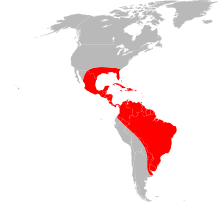Amblyomma cajennense
| Amblyomma cajennense | |
|---|---|

| |
| Scientific classification | |
| Kingdom: | Animalia |
| Phylum: | Arthropoda |
| Subphylum: | Chelicerata |
| Class: | Arachnida |
| Order: | Ixodida |
| Family: | Ixodidae |
| Genus: | Amblyomma |
| Species: | A. cajennense
|
| Binomial name | |
| Amblyomma cajennense (Fabricius, 1787)
| |

| |
Amblyomma cajennense or Cayenne tick is a species of tick found in a range from the southern part of the United States to northern Argentina, through Central America and some of the Caribbean.
A 2014 study[1] asserts that Amblyomma cajennense s.s. is found only in the Amazonian region of South America, whereas the species reported from the northern part of the Inter-Andean valley of Peru is A. interandinum, the species present from Texas (U.S.A.) to western Ecuador is , the species that occurs in the Eastern Cordillera of Colombia is A. patinoi, the species associated with the dry areas of the Chaco region spanning from central-northern Argentina to Bolivia and Paraguay is A. tonelliae, and the species distributed from the humid areas of northern Argentina to the contiguous regions of Bolivia and Paraguay and the coastal and central-western states of Brazil is .
Clinical significance[]
A. cajenennense can transmit Rocky Mountain spotted fever.[2]
In August 2009, Brazilian researchers announced that a protein called found in the saliva of the tick proved effective in stopping the growth of certain cancer cells in laboratory mice.[3]
References[]
- ^ "CDC - Rocky Mountain Spotted Fever: Questions and Answers | Tickborne Rickettsial Diseases". 2018-08-06. Archived from the original on 29 April 2010. Retrieved 2010-04-17.
- ^ "Ticks Spit Could Help Fight Cancer" redOrbit.com
- Amblyomma
- Animals described in 1787
- Parasites of birds
- Arachnids of South America
- Acari stubs